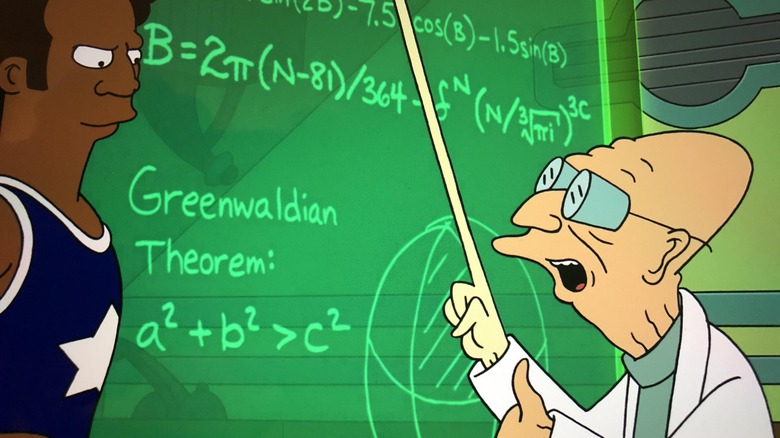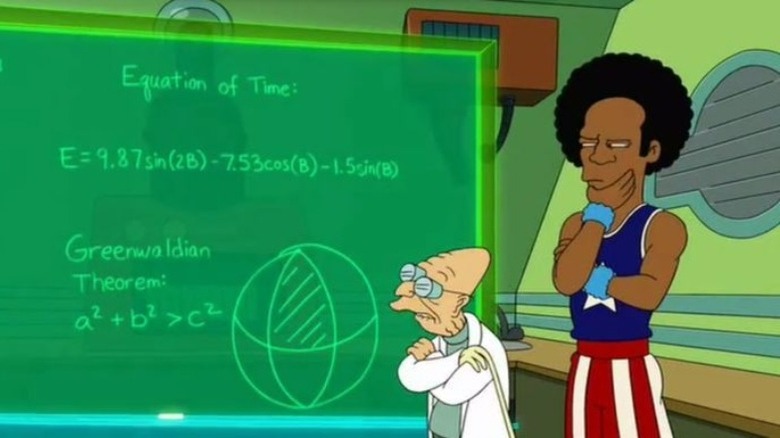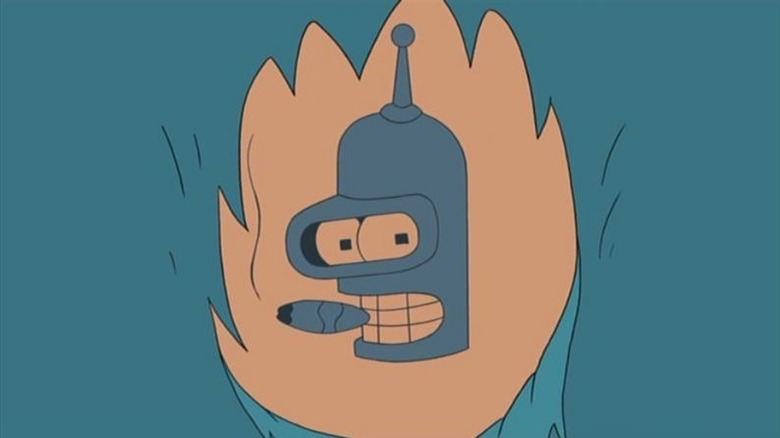Futurama's Time Equation Has An Actual, Practical Real-World Use
In the 2007 "Futurama" movie "Bender's Big Score," a trip to a nude beach planet reveals that Fry (Billy West) has a tattoo on his posterior that he didn't know was there. It seems, unbeknownst to the poor dope, that someone tattooed a miniature portrait of his robot pal Bender (John DiMaggio) on his right buttock. A closer look at the tattoo reveals a hidden binary code that, when read aloud by a robot, opens a portal in time. Unfortunately for everyone, Bender falls under the control of a trio of evil nudist online scam aliens, and they use Bender's newfound time travel abilities to send him into the past and plunder history's most priceless artifacts.
More than anything, however, Professor Farnsworth (West) is frustrated that time travel exists at all. As a scientist, he understands that the laws of physics make it impossible, at least not without creating causality loops and paradoxes. To prove it mathematically, the Professor calls in the smartest mathematician he knows, Ethan "Bubblegum" Tate (Phil LaMarr) of the Harlem Globetrotters. Together, they work out various calculations on a blackboard. No, it seems that paradox-free time travel cannot exist.
It's worth noting that many of the writers on "Futurama" possess advanced science and math degrees (show co-creator David X. Cohen has bragged in the past that the "Futurama" writers' room contains a collective of 50 years at Harvard), so anytime numbers appear on a blackboard, one can be sure that they are genuine formulae with actual meaning. This was the case with Farnsworth's and Bubblegum's formula, a formula penned by the show's math expert Sarah Greenwald. Cohen explained the math on the film's DVD commentary track.
It turns out the formula is used to correct sundials.
E = 9.87sin(2B) - 7.53cos(B) - 1.5sin(B)
The equation is called, quite mystically, the Equation of Time, or EOT and is written thus:
E = 9.87sin(2B) – 7.53cos(B) – 1.5sin(B).
On the commentary track, Cohen talks about the EOT, and what the "Futurama" writers did to tinker with it for sci-fi reasons. He said:
"[T]he equation of time. Look it up on the internet, quite interesting. It is the equation for correcting the time given by a sundial. So you know what day of the year it is, you can correct to the right time using that equation. Although we added one extra term to what is about to be written here as the 'doom field.' So that one with the delta, the greek letter at the end, that very last part we added. But the rest is the time equation."
To quote the website Sus Design, the equation of time is "a formula used in the process of converting between solar time and clock time to compensate for the earth's elliptical orbit around the sun and its axial tilt." Because the Earth doesn't rotate in a perfectly round pattern, and because it is tilted on its access, sundials will not be wholly accurate throughout the year. To account for the solar drift, as it were, the EOT can be applied to give one a good idea as to how it would need to be adjusted throughout the year.
Indeed, only in mid-April, mid-June, and right at the end of August would a sundial not need to be adjusted from a central standard. In early February and early November, a sundial will need to be adjusted as much as 15 minutes in either direction.
The Greenwaldian Theorem
One might look at the Professor's blackboard and note that he is writing about something called the Greenwaldian Theorem. There is no actual Greenwaldian Theorem, and the name was invented as an homage to the "Futurama" math consultant Sarah Greenwald, mentioned above. On the commentary track, Cohen said:
"Sarah Greenwald is a math professor who lectures about the math jokes in 'The Simpsons' and 'Futurama.' So as an extra on this DVD will be her, Professor Greenwald, lecturing about math in Futurama, including some things from this movie."
One might be able to find Greenwald's math lecture online. Its title is "Bite My Shiny Metal X."
The math references on "Futurama" are always exhilarating. Later in "Bender's Big Score," Bubblegum uses some of his mathematical razzle-dazzle to account for time travel paradoxes to "use variation of parameters and expand the Wrońskian." This is in reference to square matrix math that is used to study of differential equations. It is used to show the linear independence of a set of solutions. Any fifth grader could have told you that! Authored by Józef Hoene-Wrońsky, a common household name!
Incidentally, the binary code on Fry's butt is little more than the numbers one through six, presented vertically. Sadly, there aren't any hidden binary messages.


